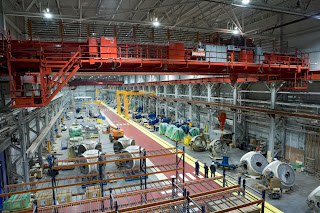States are serious about offshore wind
 The 28 U.S. coastal states consume 78% of the nation's electricity. The Atlantic east coast states produce none of the electricity used by their ratepayers. Meanwhile the country's largest untapped source of energy lies just miles off their coasts. (GW)
The 28 U.S. coastal states consume 78% of the nation's electricity. The Atlantic east coast states produce none of the electricity used by their ratepayers. Meanwhile the country's largest untapped source of energy lies just miles off their coasts. (GW)Commentary:
O'Malley's proposal to ramp up offshore wind power is a jobs generator
By Brandi Colander
Washington Post
Monday, February 21, 2011; 17
Maryland Gov. Martin O'Malley wasn't tilting at windmills when he recently announced a plan to ramp up offshore wind power. He was mapping a course to clean the air we breathe, fight climate change, create jobs, reduce health costs and bring industry to the state all at the same time. And he's doing it in the perfect time and place: The number of unemployed Marylanders now tops 219,000, and the state is suffering disproportionately high health impacts because of its reliance on dirty fuels.
O'Malley (D) revealed a forward-looking business proposal, the Maryland Offshore Wind Energy Act, under which state utilities would provide their customers with energy produced at wind farms slated for development off the state's coast, by entering into long-term contracts with the facilities.
Offshore wind would put Marylanders to work in good jobs that can't be sent overseas. Labor leaders have demonstrated early support of the bill, noting that it would not only create jobs at the facilities, but give Maryland the opportunity to become a hub for the supply chain of the industry. With the United States well positioned to become a competitive global leader in the field, we can start in Maryland's waters and attract manufacturers of the many precision parts used in the assembly and construction of offshore wind farms to the state. With employment estimates at about one job created per megawatt and O'Malley's plan exploring the development of a 400- to 600-megawatt wind farm, that could mean 400 to 600 upfront jobs for Marylanders, and thousands of jobs to support this industry over time.
Next door in Virginia, offshore wind jobs are already getting off the ground and companies are investing because they believe in the return. On Feb. 10, Gamesa Technology Corp. and the shipbuilding operations of Northrop Grumman launched an Offshore Wind Technology Center in Chesapeake. Their plans include developing America's first offshore wind turbines by late next year and they've already hired 50 engineers to start. This is tangible proof that clean energy can put Americans to work while merging the technologies of the future with those we've depended on for generations.
The environmental benefits of this also would be great. A single medium-sized offshore wind farm can reduce climate change pollution by almost a million tons per year, the equivalent of taking more than 150,000 cars off the road, and can slash emissions of air pollutants that cause respiratory and heart disease by 2,000 tons. And there is enormous potential for this clean energy source in the state -- one recent study by the University of Delaware found that Maryland has the potential to meet nearly 70 percent of its electricity needs with wind power generated off its shores.
O'Malley's proposal would end the cycle of escalating electricity bills Maryland has seen in recent years -- doubling from 1999 to 2009 alone. While the governor's office estimates it will add $1.61 to monthly bills beginning in 2016, using a Delaware offshore wind project as a model and not accounting for price suppression impacts, rates are projected to actually decline every year after. This relatively small upfront increase would ensure we have access to even cheaper energy in the future. That's because wind is free, while fossil fuel prices will only continue to climb and remain volatile.
Developing Maryland's offshore wind power potential is common sense. By taking concrete steps to cost-effectively transition from deadly coal to clean, appropriately located offshore wind energy, O'Malley can put Marylanders back to workand make the world safer for our children. That's a win for everyone.
Brandi Colander is attorney in the Air & Energy Program at the Natural Resources Defense Council.

0 Comments:
Post a Comment
<< Home